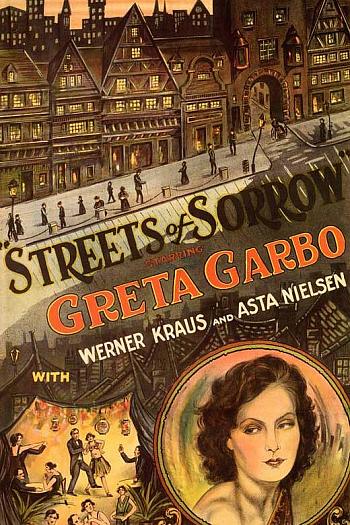
悲情花街
| 导演: | G·W·帕布斯特 |
| 编剧: | 胡戈·贝陶尔 / Willy Haas |
| 主演: | Asta Nielsen 葛丽泰·嘉宝 Agnes Esterhazy Werner Krauß Karl Etlinger Valeska Gert |
| 制片国家/地区: | 德国 |
| 类型: | 剧情 |
| 语言: | 德语 |
| 年代: | 1925 |
| 片长: | 125 分钟 / France: 94 |
| 豆瓣评分: | 0 |
| IMDB: | 0 |
| 影伴评分: | 0 |
剧情简介
Die freudlose Gasse (The Joyless Street), directed Georg Wilhelm Pabst from a script by Willy Haas, based on a novel by Hugo Bettauer, is not only one of the most important films of the Weimar Republic, it is also one of the most spectacular censorship cases of the era. While the film made its director famous, the state institutions of control guaranteed that no one would ever ... (展开全部)
Die freudlose Gasse (The Joyless Street), directed Georg Wilhelm Pabst from a script by Willy Haas, based on a novel by Hugo Bettauer, is not only one of the most important films of the Weimar Republic, it is also one of the most spectacular censorship cases of the era. While the film made its director famous, the state institutions of control guaranteed that no one would ever see the film in its original form. The film was considered too much of a provocation. Its story from the inflationary period in Vienna in the years immediately after World War I offered enough dynamite for several muckraking novels: nouveau riches currency and stock market speculators who wallow in Babylonian luxury, homeless and unemployed Lumpenproletariat living in barns, women who sell their souls for a bit of fresh meat at the butcher's, arrogant but impoverished former bureaucrats unaware of their social slide, young social climbers willing to prostitute themselves with high society women, sexual orgies and bordellos, murder out of jealousy, murder out of despair, and, finally, a revolution in the streets.
Contemporary film critics, as well as film historians have always recognized The Joyless Street as a seminal film, a film on the border between German Expressionism and Neue Sachlichkeit (new realism). Two quotes from contemporary reviews may illustrate the point: the Berliner Tageblatt wrote: "In terms of its acting, this is a beautiful film with great direction and wonderful actors." In fact, the film starred Asta Nielsen, Werner Kraus, Hertha von Walter, and a young Greta Garbo who would go on to a stellar career in Hollywood. In the Deutsche Allgemeine Zeitung, Otto Friedrich wrote: "He (Pabst) achieves his goal in great style, does not tread on well-worn paths, presents new ideas which are uniquely his own, and with this achievement gives us a new hope. He captures the atmosphere of an idea, keeps redrawing it on the surface in ever more intensive images, in contrasts of action that make an ever stronger impression. He illustrates the down-trodden souls of the era and the manic lust for pleasure of its people who are trying to do nothing more than escape for a few minutes from the terrible truth of the present."
Not only was the film cut for political and moral reasons in every country where it was publicly shown, it was also reedited in order to close the huge gaps created by censorship cuts. Thus, in almost every country totally different narratives of The Joyless Street emerged. According to Mark Sorkin, Pabst's editor, he and Pabst had made the first cuts the night before the premiere, because the theatre owner insisted the film be shortened. While the first version of The Joyless Street still had a length of 3738 meters (only four meters were initially cut by the censorship board on 25 May 1925), the film was back in court on 29 March 1926, because the police had issued a decree calling for a total ban on the film, due to its "lewd" and " seditious" tendencies. Now only 3477 meters remained of the film. None of the later surviving versions ever came close to this length. Neither a German version, nor the original German censorship cards are known to exist.
Everyone who has seen the new reconstruction of The Joyless Street agrees that it is a vast improvement over all previously existing versions. Yet it remains only a subjective attempt at a reconstruction. While it is true that the reconstruction team tried to base every one of it decisions on documentary evidence, it must also be admitted that without a surviving original German version, we will never know what the film really looked like. Given the incredible complexity of the narrative, involving at least six different subplots, and the fact that the film is still missing at least 700 meters, this version must be characterized as at attempt at a reconstruction.
Jan-Christopher Horak
Die freudlose Gasse (The Joyless Street), directed Georg Wilhelm Pabst from a script by Willy Haas, based on a novel by Hugo Bettauer, is not only one of the most important films of the Weimar Republic, it is also one of the most spectacular censorship cases of the era. While the film made its director famous, the state institutions of control guaranteed that no one would ever ... (展开全部)
Die freudlose Gasse (The Joyless Street), directed Georg Wilhelm Pabst from a script by Willy Haas, based on a novel by Hugo Bettauer, is not only one of the most important films of the Weimar Republic, it is also one of the most spectacular censorship cases of the era. While the film made its director famous, the state institutions of control guaranteed that no one would ever see the film in its original form. The film was considered too much of a provocation. Its story from the inflationary period in Vienna in the years immediately after World War I offered enough dynamite for several muckraking novels: nouveau riches currency and stock market speculators who wallow in Babylonian luxury, homeless and unemployed Lumpenproletariat living in barns, women who sell their souls for a bit of fresh meat at the butcher's, arrogant but impoverished former bureaucrats unaware of their social slide, young social climbers willing to prostitute themselves with high society women, sexual orgies and bordellos, murder out of jealousy, murder out of despair, and, finally, a revolution in the streets.
Contemporary film critics, as well as film historians have always recognized The Joyless Street as a seminal film, a film on the border between German Expressionism and Neue Sachlichkeit (new realism). Two quotes from contemporary reviews may illustrate the point: the Berliner Tageblatt wrote: "In terms of its acting, this is a beautiful film with great direction and wonderful actors." In fact, the film starred Asta Nielsen, Werner Kraus, Hertha von Walter, and a young Greta Garbo who would go on to a stellar career in Hollywood. In the Deutsche Allgemeine Zeitung, Otto Friedrich wrote: "He (Pabst) achieves his goal in great style, does not tread on well-worn paths, presents new ideas which are uniquely his own, and with this achievement gives us a new hope. He captures the atmosphere of an idea, keeps redrawing it on the surface in ever more intensive images, in contrasts of action that make an ever stronger impression. He illustrates the down-trodden souls of the era and the manic lust for pleasure of its people who are trying to do nothing more than escape for a few minutes from the terrible truth of the present."
Not only was the film cut for political and moral reasons in every country where it was publicly shown, it was also reedited in order to close the huge gaps created by censorship cuts. Thus, in almost every country totally different narratives of The Joyless Street emerged. According to Mark Sorkin, Pabst's editor, he and Pabst had made the first cuts the night before the premiere, because the theatre owner insisted the film be shortened. While the first version of The Joyless Street still had a length of 3738 meters (only four meters were initially cut by the censorship board on 25 May 1925), the film was back in court on 29 March 1926, because the police had issued a decree calling for a total ban on the film, due to its "lewd" and " seditious" tendencies. Now only 3477 meters remained of the film. None of the later surviving versions ever came close to this length. Neither a German version, nor the original German censorship cards are known to exist.
Everyone who has seen the new reconstruction of The Joyless Street agrees that it is a vast improvement over all previously existing versions. Yet it remains only a subjective attempt at a reconstruction. While it is true that the reconstruction team tried to base every one of it decisions on documentary evidence, it must also be admitted that without a surviving original German version, we will never know what the film really looked like. Given the incredible complexity of the narrative, involving at least six different subplots, and the fact that the film is still missing at least 700 meters, this version must be characterized as at attempt at a reconstruction.
Jan-Christopher Horak




